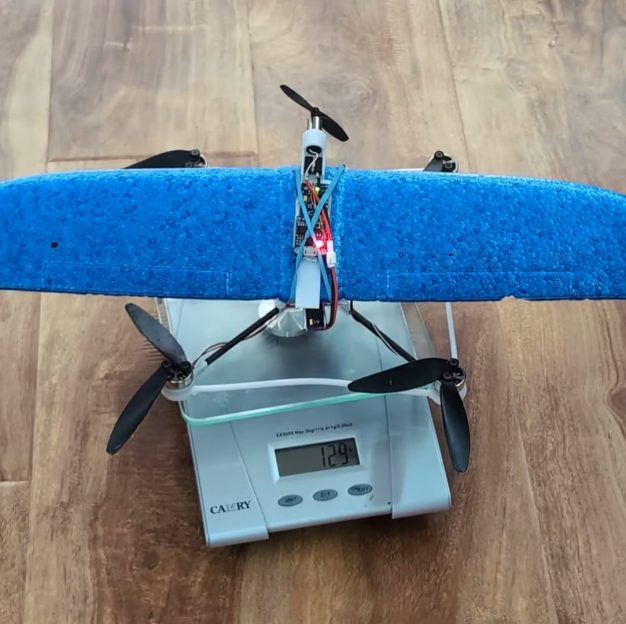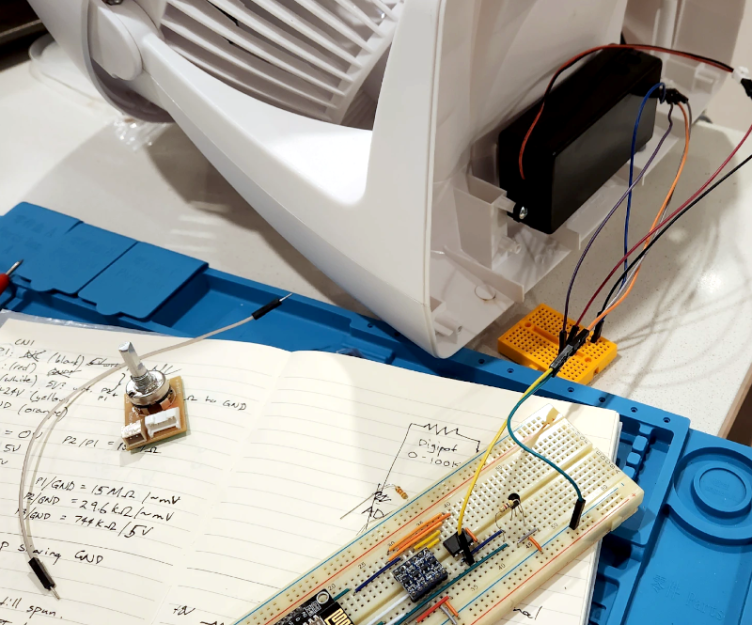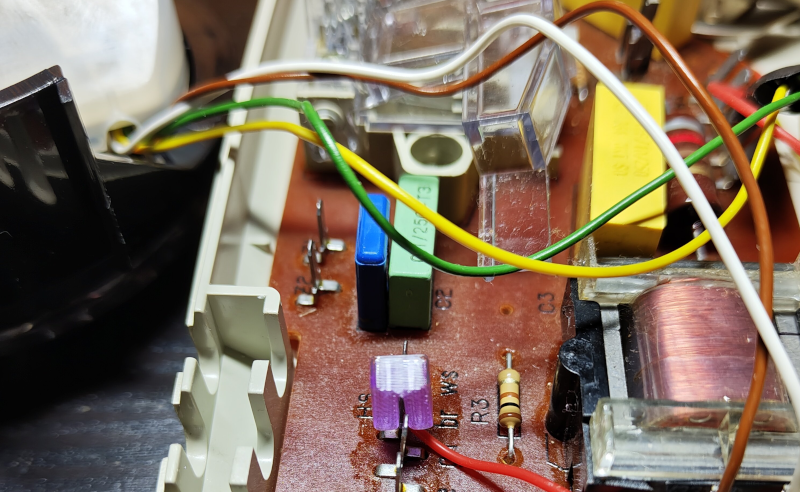2025-11-15 20:00:42

While most of the world’s venture capital is off chasing anything with “AI” in the name in what many think looks increasingly like an inflated spherical film of soap molecules, in aviation all the hot money is betting on eVTOL: electric vertical take off and landing.
What if you want to get in on the eVTOL game but don’t have (or want) billionaire backing? Long-time contributor [spiritplumber] demonstrates how to do it on the cheap, with a low-cost quadcopter and a foam wing called Lift5.
Most eVTOL isn’t just quadcopters, after all — multirotors are great for playing with in the back yard, but their thrust-based lift makes for short range, and the engine-out options are all bad. Add a wing, and you can get that sweet, sweet dynamic lift. Add an extra, forward facing motor, and you can get thrust in the direction you need it most. That’s what [spiritplumber] is doing here: strapping a foam wing to a cheap quadcopter. Specifically, his custom frame for an Eiele F120 drone kit.You can see it in action in the demo video embedded below.
The wing and its forward thrust motor are equipped with its own speed controller, so the concept should be adaptable to just about any little drone. Quadcopter flight computers are mostly going to be able to compensate for the added lift and thrust automatically, which is neat, considering that these forces would require some bizarre headwind/updraft very unlikely to be found in nature.
Now the wing does add a lot of drag during the lift phase, to be sure, so [spiritplumber] is working on folding or tilting it out of the way, but that version is apparently inordinately fond of trees. Once the control issues are worked out you’ll likely see it on his site and YouTube channel Robots Everywhere.
[spiritplumber] has been contributing hacks here at least since 2009, when he showed us how to make a Macbook right click.
2025-11-15 17:00:26

Given that we live in the proverbial glass house, we can’t throw stones at [ellis.codes] for modifying a perfectly fine Vornado fan. He’d picked that fan in the first place because, unlike most fans, it had a DC motor. Of course, DC motors are easier to control with a microcontroller, and next thing you know, it was sporting an ESP32 and a WiFi interface.
The original fan was surprisingly sparse inside. A power supply, of course, and just a tiny PCB for a speed control. Oddly, it looks like the speed control was just a potentiometer and a 24 V supply. It wasn’t clear if the “motor” had some circuitry in it to do PWM control or not. That seems likely, though.
Regardless, the project opted for a digital pot IC to maintain compatibility. One nice thing about the modification is that it replaces the existing board with the same connectors. So if you wanted to revert the fan to normal, you simply have to swap the boards back.
Now the fan talks to home automation software. Luckily, there’s still nothing wrong with it. We love seeing bespoke ESPHome projects. Even if your fan has WiFi, you might not like it communicating with Big Brother.
2025-11-15 14:00:14

While you might not know it from their market share, Intel makes some fine GPUs. Putting one in a PC with an AMD processor already feels a bit naughty, but AMD’s x86 processors still ultimately trace their lineage all the way back to Intel’s original 4004. Putting that same Intel GPU into a system with an ARM processor, like a Raspberry Pi, or even better, a RISC V SBC? Why, that seems downright deviant, and absolutely hack-y. [Jeff Geerling] shares our love of the bizarre, and has been working tirelessly to get a solid how-to guide written so we can all flout the laws of god and man together.
According to [Jeff], all of Intel’s GPUs should work, though not yet flawlessly. In terms of 3D acceleration, OpenGL works well, but Vulkan renders are going to get texture artifacts if they get textures at all. The desktop has artifacts, and so do images; see for yourself in the video embedded below. Large language models are restricted to the not-so-large, due to memory addressing issues. ARM and RISC V both handle memory somewhat differently than x86 systems, and apparently the difference matters.
The most surprising thing is that we’re now at a point that you don’t need to recompile the Linux kernel yourself to get this to work. Reconfigure, yes, but not recompile. [6by9] has a custom kernel all ready to go. In testing on his Pi5, [Jeff] did have to manually recompile Mesa, however–unsurprisingly, the version for Raspberry Pi wasn’t built against the iris driver for Intel GPUs, because apparently the Mesa devs are normal.
Compared to AMD cards, which already work quite well, the Intel cards don’t shine on the benchmark, but that wasn’t really the point. The point is expanding the hardware available to SBC users, and perhaps allowing for sensible chuckle at the mis-use of an “Intel Inside” sticker. (Or cackle of glee, depending on your sense of humour. We won’t judge.) [Jeff] is one of the people working at getting these changes upstreamed into the Linux kernel and Raspberry Pi OS, and we wish him well in that endeavour.
Now, normally we wouldn’t encourage a completely unknown fellow like this [Jeff] of whom no one has ever heard of to be poking about in the kernel, but we have a good feeling about this guy. It’s almost as if like he’s been at this a while. That couldn’t be, could it? Surely we’d have noticed him.
2025-11-15 11:00:15

It isn’t unusual to expect a precisely regulated voltage in an electronic project, but what about times when you need a precise current? Over on EDN, prolific [Stephen Woodward] explains how to use a precision Zener diode to get good results. [Stephen] takes you through the math for two topologies and another circuit that uses a pair of bipolar transistors.
You might wonder why you need a precise current source or sink. While it is nice to drive things like LEDs with a constant current, you probably don’t need ultra-precise currents. However, charging a capacitor with a constant current produces a very nice linear voltage ramp. When you use a resistor to bias collector current in a bipolar amplifier, you are just poorly imitating a constant current source, too. That’s just two of many examples.
The circuits use a MOSFET to handle the actual current path, so there are a few differences depending on whether you want to sink or source current. You may wonder why a precision Zener diode needs an external Zener. However, if you read the text, you’ll note that’s only if the input voltage is too high for the “real” Zener.
There are many techniques for manipulating currents. All good to have in your toolbox.
2025-11-15 08:00:02


It’s part of the great circle of life that toys and scale models that provide a reflection of macro-sized objects like vehicles and buildings will eventually be scaled up again to life-sized proportions. Case in point the LEGO Technic dune buggy that [Matt Denton] recently printed at effectively human scale, while also making it actually drivable.
The basis for this project is the 8845 Dune Buggy which was released in 1981. Unlike the modern 42101 version, it’s more straightforward and also seems more amenable to actually sitting in despite featuring more pieces for a total of 174 pieces. Naturally, [Matt] didn’t simply go for a naïve build of the 8845 buggy, but made a few changes. First is the scale that’s 10.42 times larger than the LEGO original, based around the use of 50 mm bearings. The model was also modified to be a single-seater, with the steering wheel placed in the center.
With some structural and ergonomic tweaks in place, the resulting CAD model was printed out mostly in PLA with a 1 mm nozzle and 10% infill using a belt FDM printer to help with the sheer size of the parts. After that it was mostly a LEGO kit assembly on a ludicrous scale that resembles a cross between building a LEGO kit and assembling Ikea flatpack furniture.
At merely the cost of most of his sanity, [Matt] finally got the whole kit together, still leaving a few suspension issues to resolve, as it turns out that so much plastic actually weighs a lot, at 102 kg. With that and other issues resolved, the final touch was to add an electric motor to the whole kit using a belt-driven system on the rear axle and bringing every LEGO minifig’s dreams to life.
After a few test drives, some issues did pop up, including durability concerns and not a lot of performance, but overall it performs much better than you’d expect from a kid’s toy.
2025-11-15 05:00:41

We suspect kids today — and some adults — are confused about phone terminology. In today’s world, “hanging up” and “dialing,” for example, are abstract words without the physical reference that older people remember. But some people have a soft spot for the old rotary dial phones, including [Stavros], who wired a rotary phone to his computer for use on online meetings. Check out the video below.
He took an old rotary phone and wanted to program a Raspberry Pi Zero to act as a sound card and a keyboard. That way, he could connect to the meeting by picking up the handset and disconnect by hanging up. He also planned to read the dial and convert that into keyboard input.
If that sounds like a big project, it’s because it is. [Stavros] decided to use Claude Opus 4.1 to write the code for him, but was stymied by the $200/month price tag. So he wrote some code to send queries on a pay-as-you-go plan. After $50 was spent, the code was in worse shape than the first version. So much for vibe coding.
Plan B was — his words, not ours — shameful. He used a cheap USB sound card, an RP2040 to act like the keyboard, and a hub to make it simple to connect. Cases were removed, and boards were integrated into the phone to make a working project.
We do appreciate that [Stavros] tries not to irreversibly damage the old gear when he makes a mod like this. He uses a 3D printed connector to replace the old press-fit connections on the phone’s PCB, and it is all highly reversible.
While Claude didn’t help the development much, perhaps [Stavros] can use the phone to talk to Claude. We’ve seen a number of rotary phone hacks over the years.